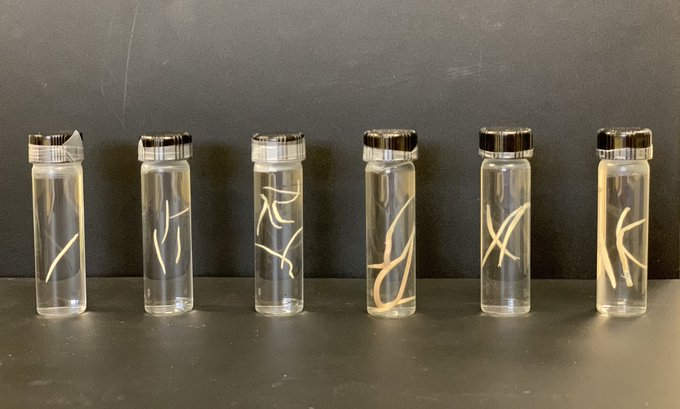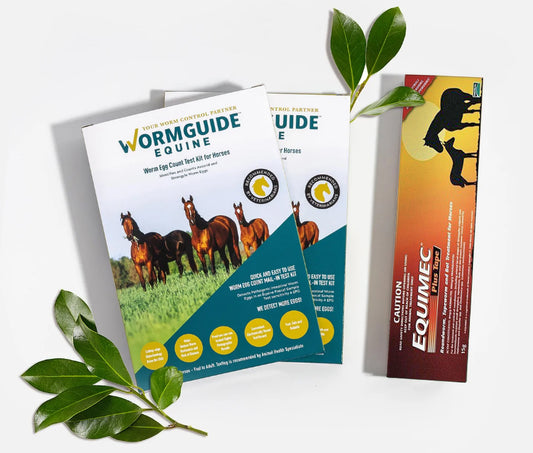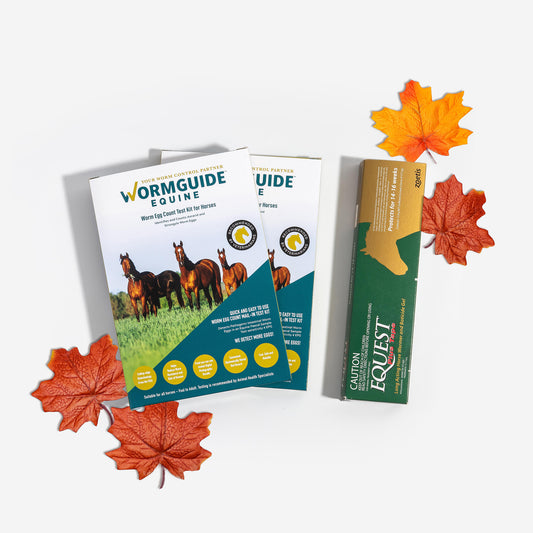In this guide, we’ll explore the signs and symptoms of worm related health issues, types of horse worms and address the recent changes on how to manage them.
What Are the Signs and Symptoms of Worm related disease in Horses?
Horses are exposed to a mixture of intestinal worms.The symptoms of a parasite infection can vary depending on the type of worm involved and the number of worms infecting the horse. When present in low numbers, worms cause minimal problems. In fact, Craig Reinemeyer DVM PhD, a renowned expert states: Horse worms have co-evolved with the horse over 60 million years of evolution. We need to manage worms. Not over worm horses in an attempt eradicate them. Our efforts at eradication are what have led us to the problem of resistance.
Resistance brings with it increasing amounts of untreatable parasitic disease and that is a serious welfare issue for our horses.
Dr Martin Nielsen, foremost expert on equine parasitology in the world points out that it is natural for horses to have worms - it`s a natural state and that an immune system that co-evolves with worms is best, as the worms stimulate and improve the immune system.
But when worm burdens are too high, worms can seriously compromise horse health.
Keep in mind, clinical signs and symptoms are non-specific and could be caused by other conditions and worms could be part of the problem.
The best horse worming practice to avoid parasitic disease is an effective worm control that you know works for your horses on your property. No one program suits all horses or all geographical areas. In fact, even horses on one property can have a different worm control than another down the road. Without faecal worm egg count testing it is impossible to build a meaningful and sustainable worm control for happy healthy horses and slow the development of de-wormer resistance on your property.
What Types of Worms Infect Horses?
Several types of parasites can infect horses, and each can cause different signs and symptoms. Here is an overview of the most common offenders:
1. Threadworms (Strongyloides Westeri)
Not to be confused with an entirely different worm called the NeckThreadworm!
The threadworm is primarily a foal parasite. This parasite has three ways of entering the foal`s body. Foals eat the infective stages, they can go through the skin or from the mare to the foal through the milk. It is generally not considered a major cause of diarrhoea. When the larvae go through the skin, signs of distress such as a sudden onset of stomping, walking quickly, scratching the face, ears and neck with their hind feet are observed. Foals appear to develop immunity between the time of weaning and about 8-10 months of age.
For more about treatment trot over to our Parasite Video Library

Female threadworm.is 6-9mm
(Source: Photo Neilsen& Reinemeyer 2018 Equine Parasite Control)
2. Ascarids (roundworms)
This is the one that can cause disease in all foals. Foals are infected by ingesting infective eggs from the environment. After ingestion by the horse, eggs hatch in the intestine and the larvae (immature worms) migrate through the liver to the lungs, pass into the airways and are then swallowed, reaching the small intestine where they become adults.
Clinical Signs: Intestinal disturbances are common and diarrhoea, sometimes alternating with constipation, can be detected. Migrating larvae causes coughing. They eat the food and nutrients that the horse is supposed to get leading to poor growth, rough haircoat or `pot` belly appearance.
The major clinical disease is a painful life-threatening colic caused by a lot of roundworms clogging the long but narrow small intestine or rupturing the intestine which is not treatable. Roundworm impaction with dead worms occurs often after worming a young horse that has a heavy worm load. It is important to prevent a large accumulation of roundworm. Worm egg counts identify the presence of roundworm but do not correlate with the number of worms and risk of impaction. Horses develop immunity by 18 months and egg shedding stops. Some adult horses don`t develop immunity.
Treatment Is directed at resolving the small intestine blockage. Most horses require surgery. A conservative approach is to administer mineral oil combined with pain medication,fluid therapy and a recommended dewormer that is likely to be effective. Both procedures require antibiotics and anti-inflammatory therapy
Prevention Current worm control recommendations are designed to reduce the risk of parasitic disease through faecal worm egg count testing and routine monitoring of dewormer efficacy. It is generally recommended to target roundworm twice before weaning, with treatments given at 2 months of age and at 5 months. Use faecal worm egg counts at 5 months or just prior to weaning to identify the presence of roundworm. Always check with faecal worm egg counts to ensure the chosen worming product worked or not.
Head to our Parasite Video Library for more info

Adult ascarids in the small intestine of a weanling. They can grow to 30cm long and 6 mm wide.
(Photo: Dr Tetiana Kuzmina, Martin & Reinemeyer 2018 Equine Parasite Control)
3. Small Strongyles
Small strongyles are of major importance and the most common parasite in all horses today. Every single horse in the world with access to pasture has small strongyles. They cause the greatest disease during their larval stages. The larvae enclose themselves in cysts (like a cocoon) inside the intestinal walls. When they eventually emerge to become adults they can cause severe damage by leaving holes in the lining of the intestine, especially when large numbers of larvae emerge all at once. The technical name of this mass emergence of larvae is `larval cyathostominosis`. The typical case of acute larval cyathostominosis is a young horse (1–4 years old, rarely foals), but the condition can occur in mature horses as well.
Clinical Signs The horse has often been recently dewormed with an effective nonlarvicidal dewormer and is presenting with these clinical signs: sudden onset of profuse watery diarrhea; severe dehydration; varying degrees of circulatory shock; edema of the chest, sheath or lower legs; possible colic signs; body temperature can be elevated, normal, or decreased.
Egg counts are not useful because larval stages are not egg-producing adults.
Treatment Intensive therapy, anti-inflammatory drugs and larvicidal medication.
Prevention Current worm control recommendations are designed to reduce the risk of larval cyathostominosis through faecal worm egg count testing for yearly monitoring of dewormer efficacy and applying targeted treatments for horses that always have high egg counts. Coupled with good pasture management and regulation of stocking density, this should reduce worm egg contamination of pastures and reduce the infection pressure.

Each dot is one encysted larva. They can stay there for up to 2 years before emerging to become an adult to continue the life-cycle.
The common term `small redworm` is often used for many different small strongyle species of worms, but not all of them are actually red; most are just pale white. The early stages of only one small strongyle species appear red in colour and can be easily seen in fresh manure.

Small strongyles are very small and hard to see in your horse’s poop- Dr Martin Nielsen.
For more info click on the link to our Parasite Video Library
4. Large Strongyles( bloodworms)
Bloodworms are uncommon horse parasites these days in managed horses because they are controlled by most available horse wormers. No reported resistance to date. Large strongyles cause the greatest disease during their larval stages.This worm can cause lesions and in rare cases, blood clots block the blood vessels depriving a section of the intestine of oxygen and nutrients. This causes the intestinal tissue to die.
Clinical Signs: Infection with these parasites presents as colic - fever; red mucous membranes, decreased or no gut sounds, slightly elevated heart rate. Severe infections can result in loss of blood supply to a portion of the intestine, leading to severe and fatal colic.
Treatment: Surgery, if feasible to remove the dead section of the intestine.
Prevention: The bloodworm can re-emerge if not considered in worm control programs. Current guidelines recommend a foundation worming treatment for all horses twice a year (spring and autumn) to keep this worm at bay.
For more info swipe through to our Parasite Video Library

The bloodworm can block the blood vessels with blood clots which damage the intestine.
5. Tapeworms
The tapeworm is a notable offender because heavy infections can cause colic signs - ranging from mild cramping to severe colic that requires surgical treatment. If there’s grass, there’s going to be tapeworms. The adults of this species grow to around 2.5 cm to 8 cm.
Tapeworms infect horses by using a tiny mite that lives on grass as an intermediate host. The mite ingests the tapeworm egg and horses are at risk of developing tapeworm infection when they accidentally eat this mite while grazing. The mite releases the tapeworm into the horse’s gut. The tapeworm grows inside the horse and can cause clear signs of pain from intestinal rupture, severe inflammation, and ulceration.
In dry climatic conditions where there`s little or no grass, there`s not much tapeworm infection going on.
Treatment:Surgery, fluid and anti-inflammatory therapy and once colic has resolved a deworming treatment (praziquantel, double dose pyrantel)
Prevention: Current worm control recommendations are to treat for tapeworms twice a year (or at least once year) with the aim to reduce worm contamination of pastures and therefore reduce infection risk.
Check out this short flat worm - Parasite Video Library

Photo: Nielsen& Reinemeyer Equine Parasite Control
Adult tapeworms live and attach to the junction of the small and large intestine.
6. Bots
Bots are insects and rarely cause major health problems. They lay eggs on the hair coat and when horses groom themselves or other horses, the eggs hatch, and the larvae go into the horse`s mouth and burrow into the tissues causing lesions that can cause soreness but heal quickly. They are swallowed and attach to the stomach wall for several months and can cause lesions that generally heal. Bots are not classified as causing stomach ulceration. They pass from the horse`s body in the manure and burrow into the soil to pupate for a few months to turn into a bot fly. When bot flies hover, some horse get annoyed, but some get really frightened.
For more info fly over to our Parasite Video Library

Bot fly eggs on horse`s hair coat.

Bot fly larva. The life cycle takes about one year
7. Pinworms
Pinworms take their name from their slender, pin-like bodies with a sharply pointed tail. They grow up to 3-5 cm long and are harmless but are common culprits of a horse’s itchy rear end. Female pinworms travel a long distance from the colon where they live to lay eggs outside the anus and cause irritation, leading horses to rub their backsides spreading eggs against fences, trees, and other surfaces to relieve the discomfort.
More info about treatment? Check out our Parasite Video Library

After laying eggs female pinworms die and are found in the manure.
When Should I Worm My Horse?
There have been recent changes in our understanding of worms and how to manage them.
The problem of resistance is increasing at an alarming rate, it is rampant to all worming medication classes. Best practice guidelines provide a solution to manage our way around this. We can`t stop resistance. The only thing we can really do is to delay the development rate of drug resistant worms. Once it develops, it never goes away.
Today we know that the true goal of parasite control in horses is not to try to eradicate all parasites from the animals, but to control worm infections so that animals remain healthy and free of clinical illness. Worming too much, attempting to eradicate worms in horses is proven impossible and just drives worms to be resistant to the worming drugs used.
Best practice guidelines recommend that every adult horse over 3 years receive a basic foundation worming treatment twice a year at the right time that will interrupt the life cycle of important worm infections – large strongyles, small strongyles and tapeworm.
All horses have individual worming needs. The best worm control for any situation must be based on worm egg count testing to identify the horses that shed the most eggs on pasture. These horses get additional worming treatments. Worm egg counts identify the low, moderate and high shedders.
Parasite risk factors can make horses more susceptible to parasitic worm infection - age, health, local climate, stress, manure removal, pasture management, time on pasture, and movement of horses on and off the horse property.
After assessing the worm egg count shedding levels and your adult horse`s parasite risk factors, an individual sustainable worm control for each horse can be designed for preventive care and delay development of resistant worms.
Horses less than about 3 years of age require a different worm control as they are more susceptible to parasitic worm infection. Just prior to weaning, worm egg counts are recommended to determine whether worm burdens are primarily strongyles or ascarids to select the right worming product. This is a stressful time for the foal and large worm burdens would just make it worse.
The performance of your chosen egg count test matters more than you think!

Check the effectiveness of the worming product you are using with reliable worm egg count tests. This is the starting point for sustainable worm control.The only way to check the efficacy of the worming product you are using is to conduct a worm egg count reduction test - an egg count before treatment and another 10-14 days later to compare results.The performance of an egg count technique is essential for up-to-date sustainable worm control guidance. WormGuide provides the preferred performance parameters for testing the effectiveness of the worming product you are using.
Monitor the egg shedding levels of individual horses for the recommended sustainable worm control. The goal is to reduce the amount of worm eggs on pasture by targeting (selecting) the horses that release most of the eggs in their manure. Horses that always have high egg counts infect themselves and other horses with worms. It does not mean they have more worms inside them. WormGuide provides the preferred performance parameters for identifying high egg shedding horses for sustainable worm control.
It is important to monitor the presence of ascarid (roundworm) in foals, weanlings and yearlings to select the most appropriate worming product. WormGuide provides the preferred performance parameters for young horse sustainable worm control!
Check out the top test tips

Test the efficacy of the worming product you use?
"Even the cheapest dewormer can be the most expensive if it doesn`t work and you keep using it," says Dr Martin Nielsen.
Want to know how to check? Try our Truth Teller Test to find out if the worming drug you are using for your horse kills the worms!
Want to know if you have drug resistant worms living inside your horses and on your pastures? Try our Resistance Detection Service for herd health.
We love horses as much as you. Visit our site for more information about building sustainable worm control that work.
Shop now to get our custom-made faecal sample collection Kit and science-based faecal egg count analysis.
Join the movement changing worm control habits to secure the future for our horses and protect them from the ever-present threat of horse wormer resistance.











